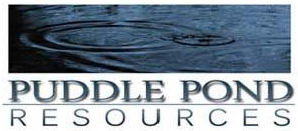- BY TiVaHostAdmin
- POSTED IN Heritage Gold and Silver Project, News
- WITH 0 COMMENTS
- PERMALINK
- STANDARD POST TYPE
Puddle Pond Resources Inc. is pleased to announce the recently completed drilling program has produced highly positive assay results that indicate a very robust mineralized zone which was first outlined in surface trenching completed in late 2012. The target zone of low sulphidation, epithermal alteration was intersected in all 5 holes drilled and all 316 core samples from the zone yielded gold (Au), accompanied by silver (Ag) mineralization.
The intense silica (quartz) alteration zone is dipping steeply to the west and the mineralized intersections range between 50 and 82 metres thick, which appear to represent the true thickness of the zone. Gold assays are consistently above 0.02 g/t and range up to a best value of 2.4 g/t Au (over 0.5 metres). Other individual assay highlights include 1.44 g/t Au over 1.0 metres and 1.23 g/t Au over 0.6 metres, both of which are in Hole # HD-05-13, the last and most northerly hole drilled in the 1 km section selected for testing from the 3.9 km long mineralized zone outlined in 2012. HD-05-13 produced the strongest and thickest (82 metres) mineralized section of the 5 holes drilled, with a 34.83 metre section grading 0.25 g/t Au which contains a 7.0 metre section grading 0.51 g/t Au.
The consistent gold mineralization and increase in grades north along the zone correspond to the trench results, also showing silver enrichments. The drilling also confirm these silver enrichments with best values of 288 g/t (9.26 oz/t) over 0.4 m and 2.5 oz/t over 3.6 m. A 19.48 m section grading 0.61 oz/t Ag also is contained in the Au enriched section in HD-05-13. The 2012 trenching suggested the zone is thickening to the north and may reach a true thickness up to several hundred metres at the Whalesback Zone 1.5 kms north of the drill hole. Research of epithermal systems show this range of gold and silver values are very typical of the upper levels of these systems where it is common to see downward increases in Au and Ag grades. Textures observed in the trench and core samples also suggest an upper level of epithermal alteration.
The drilling was also designed to determine if there were variations in grades (and textures) important for vectoring (or pointing) towards a “sweet spot” or potentially important economic deposit typically forming a part of these epithermal systems. (At the Hope Brook past producing gold mine in the same belt of rocks to the west of Heritage the 752,000 oz gold deposit was in a 500 metre section of a 4 km alteration zone.) The noteworthy, northward increase in gold and silver grades may be pointing towards a sweet spot which can also be evidenced by bonanza grades up to 3.76 oz/t Au and 89 oz/t Ag obtained in earlier surface samples (ref. press release May 30, 2012).
The drilling and earlier trench results are identifying a mineralized area of substantial size, further suggested by the Peter’s Brook drill target located 2.5 kms east of the initial drilling.
The technical information was compiled by Victor A. French, P. Geo., a qualified person as defined by National Instrument 43-101.


